If you’ve recently been diagnosed with fractured ribs, you’re likely feeling anxious about your recovery and wondering what treatment options are available. The good news is that most rib fractures heal well with proper care, and there are many effective treatments to help manage your pain and speed your recovery. This comprehensive guide will walk you through everything you need to know about fractured rib treatment, from immediate care to long-term recovery strategies.
Understanding Fractured Ribs or broken rib or rib injury: What You Need to Know
Fractured ribs—commonly called broken ribs—are among the most common chest injuries. Your ribcage consists of 24 ribs that protect your vital organs, and while they’re designed to be flexible, they can break under significant force from accidents, falls, or direct blunt chest trauma.
The reassuring news is that simple rib fractures typically heal on their own within 6-8 weeks with appropriate treatment and care. Most patients can expect to return to normal activities gradually during this healing period.
Types of Rib Fractures
Understanding the type of fracture you have helps determine the best treatment approach:
- Simple Fractures: These involve a clean break in the rib bone without displacement (sometimes referred to as a hairline fracture). They’re the most common type and generally heal well with conservative treatment.
- Displaced Rib Fractures: When bone fragments move out of their normal position, they require more intensive monitoring and sometimes surgical intervention.
- Stress Fracture: Occurs when a bone undergoes repeated intense strain (for example, in professional sportspeople).
- Multiple Rib Fractures or Single Complex Fracture: Breaking several ribs simultaneously or one rib in several places, which may require specialised treatment and closer medical supervision.
- Flail Chest: A serious condition involving multiple consecutive rib fractures that can affect breathing mechanics and requires immediate medical attention, especially if it is accompanied by pulmonary contusion (lung bruising because of the impact to the chest) or collapsed lung
Immediate Treatment for Fractured Ribs: First Steps to Recovery
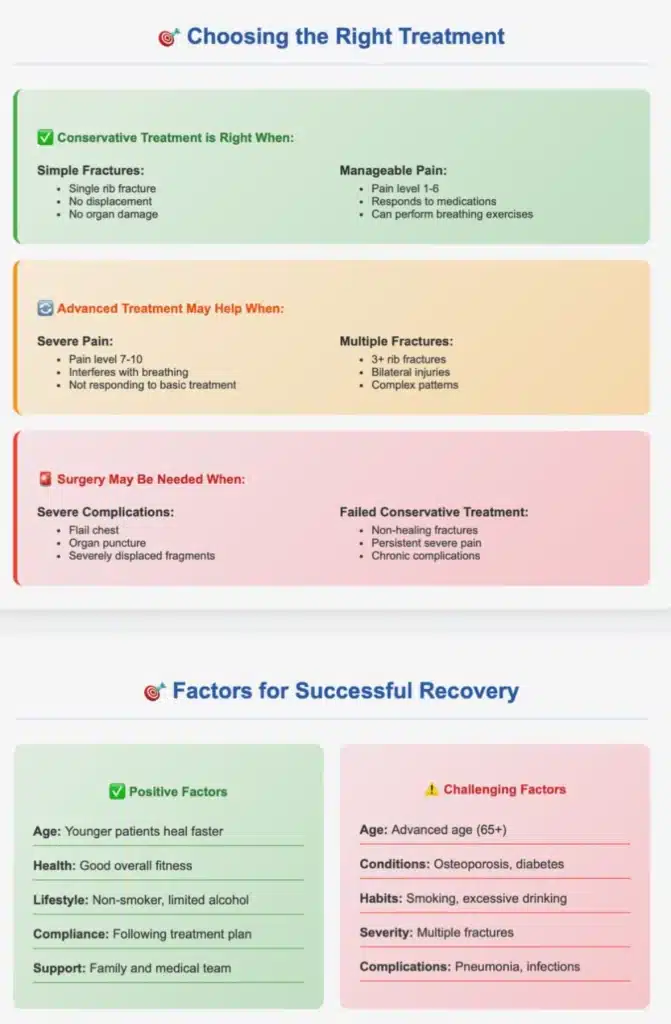
Emergency Care and Diagnosis
When you first seek medical attention for suspected rib fractures, healthcare providers will typically perform:
- Physical examination – to assess pain levels and breathing
- Chest X-rays – to visualise the fracture and rule out complications
- Chest CT – in severe cases, to get detailed images of the injur,y the three-dimensional rib cage, and overall chest wall reconstruction
- Blood tests – to check for internal bleeding or other complications
The primary goals of immediate fractured rib treatment focus on pain management, preventing complications, and supporting your body’s natural healing process.
Pain Management: Your First Priority
Effective pain control is crucial for fractured rib recovery because inadequate pain management can lead to shallow breathing, pneumonia, and delayed healing. Your healthcare team may recommend:
Over-the-Counter Medications:
- Ibuprofen helps reduce inflammation and pain
- Paracetamol provides additional pain relief
- These can often be used together safely under medical guidance
Prescription Pain Medications:
- Short-term opioid medications for severe pain
- Muscle relaxants to reduce chest wall spasm
- Topical pain relievers for localised relief
Alternative Pain Management Techniques:
- Ice therapy for the first 48-72 hours to reduce swelling
- Heat therapy after the initial inflammatory period
- Gentle breathing exercises to maintain lung function
- Positioning techniques to find comfortable sleeping and resting positions
Conservative Treatment Options: The Foundation of Recovery
Most fractured ribs respond excellently to conservative treatment, which focuses on supporting your body’s natural healing abilities while managing symptoms effectively.
Breathing Exercises and Pulmonary Care
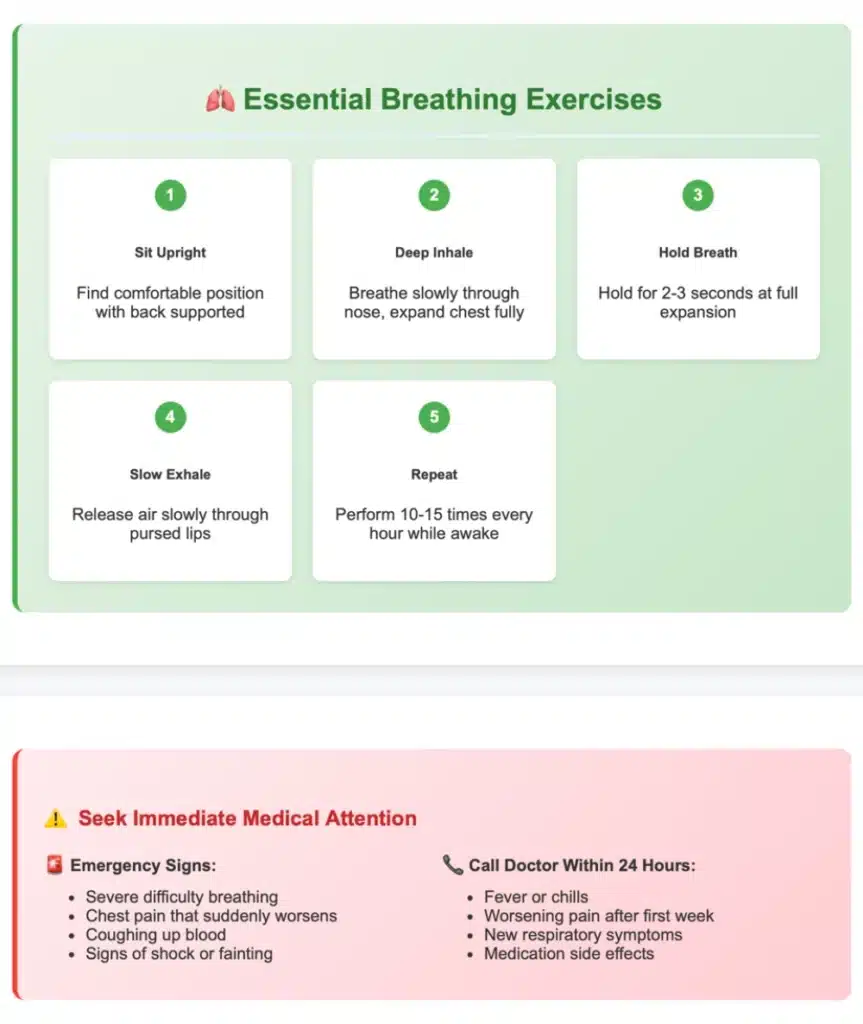
One of the most important aspects of fractured rib treatment involves maintaining proper lung function to prevent a chest infection and other respiratory complications.
Deep Breathing Exercises: Perform these exercises every hour while awake:
- Take slow, deep breaths, expanding your chest fully
- Hold for 2-3 seconds, then exhale slowly
- Repeat 10-15 times per session
- Use an incentive spirometer if recommended by your doctor
Coughing Techniques: While painful, controlled coughing helps clear your lungs:
- Support your injured ribs with a pillow when coughing
- Take a deep breath, then cough forcefully
- This prevents mucus buildup that could lead to pneumonia
Activity Modification and Rest
Finding the right balance between rest and activity is essential for optimal healing:
Initial Rest Period:
- Avoid heavy lifting (nothing over 10-15 pounds initially)
- Limit activities that cause sharp increases in pain
- Sleep in an upright or semi-upright position if lying flat is uncomfortable
Gradual Activity Increase:
- Begin with light activities like short walks
- Gradually increase duration and intensity as tolerated
- Listen to your body and don’t push through severe pain
Supportive Care Measures
Proper Nutrition:
- Eat a balanced diet rich in calcium and vitamin D for bone healing
- Include protein to support tissue repair
- Stay well-hydrated to help thin mucus secretions
Sleep Positioning:
- Sleep in a recliner or propped up with pillows
- Use additional pillows to support your injured side
- Experiment with different positions to find what’s most comfortable
Advanced Treatment Options: When Conservative Care Isn’t Enough
While most fractured ribs heal with conservative treatment, some cases require more advanced interventions.
Nerve Blocks and Injection Therapy
For patients experiencing severe pain that interferes with breathing or daily activities, targeted injection therapy can provide significant relief:
Intercostal Nerve Blocks:
- A local anaesthetic is injected near the affected nerves
- Provides hours to days of pain relief
- Can be repeated as needed during the healing process
Epidural Injections:
- For multiple rib fractures causing severe pain
- Continuous pain relief through a catheter system
- Typically used in hospital settings for severe cases
Surgical Treatment Options
Surgery for fractured ribs is relatively uncommon but may be necessary in specific situations:
Indications for Surgery:
- Severely displaced fractures threatening internal organs inside the chest cavity
- Flail chest requiring stabilisation
- Fractures that don’t heal properly (a condition called non-union).
- Persistent severe pain despite conservative treatment
Surgical Procedures:
- Rib plating: Metal plates and screws to stabilise complex fractures
- Rib resection: Removal of severely damaged rib segments
- Thoracotomy: Open chest surgery for complex cases with internal organ damage
The decision for surgical intervention is always made carefully, weighing the benefits against potential risks and considering your overall health status.
Comprehensive Rib Pain Management Strategies
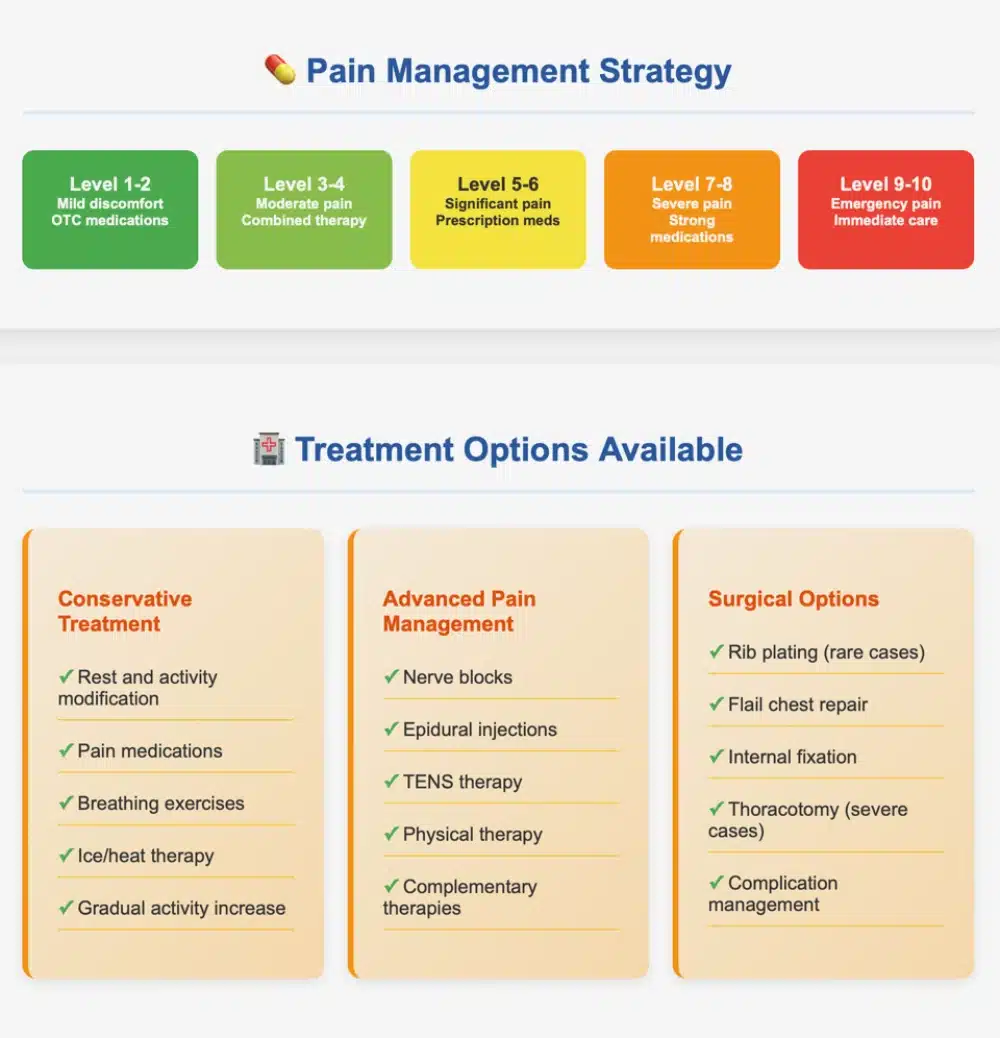
Effective pain management is crucial not just for comfort, but for proper healing and preventing complications.
Medication Management
Creating a Pain Management Plan: Work with your healthcare provider to develop a personalised approach that might include:
- Scheduled pain medications rather than waiting for severe pain
- Combination therapy using different types of pain relievers
- Gradual tapering of medications as healing progresses
Avoiding Common Pitfalls:
- Don’t skip doses to “tough it out” – this can lead to increased pain and complications
- Be aware of side effects, especially respiratory depression with opioid medications
- Communicate openly with your healthcare team about pain levels and medication effectiveness
Non-Pharmacological Pain Relief
Physical Therapy Techniques:
- Gentle stretching exercises to prevent stiffness
- Posture training to reduce strain on healing ribs
- Breathing techniques for pain management
- Progressive mobility exercises
Complementary Approaches:
- Transcutaneous electrical nerve stimulation (TENS) therapy
- Acupuncture for pain relief
- Meditation and relaxation techniques
- Massage therapy (avoiding the injured area and the affected rib)
Recovery Timeline: What to Expect During Healing
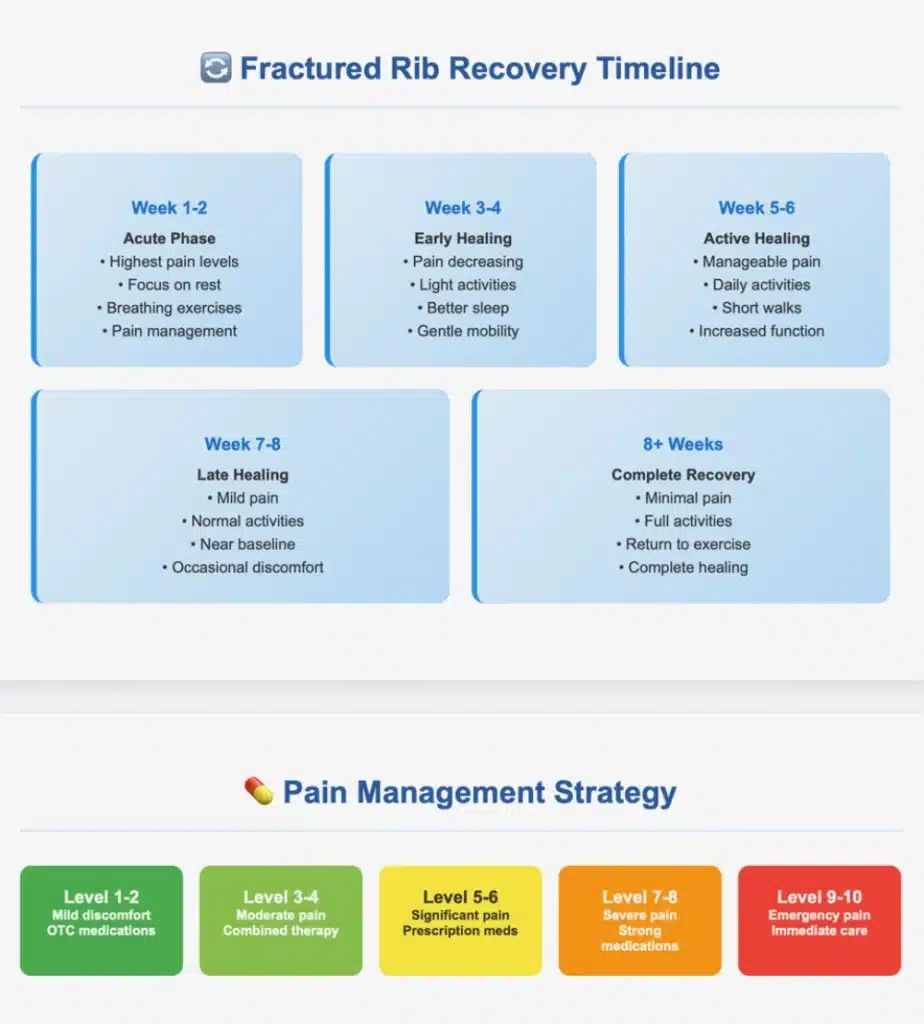
Understanding the typical healing process helps set realistic expectations and reduces anxiety about recovery.
Week 1-2: Acute Phase
- Pain levels: Highest during this period
- Activity: Rest is the primary focus, with gentle breathing exercises
- Goals: Pain control and preventing complications
- What to expect: Significant discomfort, especially with movement and breathing
Week 3-4: Early Healing Phase
- Pain levels: Beginning to decrease but still significant
- Activity: Gradual increase in light activities
- Goals: Maintaining lung function and beginning gentle mobility
- What to expect: Some improvement in comfort, ability to sleep better
Week 5-6: Active Healing Phase
- Pain levels: Moderate, more manageable
- Activity: Return to light daily activities, short walks
- Goals: Progressive increase in function while protecting healing ribs
- What to expect: Noticeable improvement in daily activities
Week 7-8: Late Healing Phase
- Pain levels: Mild to moderate with activities
- Activity: Most normal activities can be resumed
- Goals: Return to baseline function
- What to expect: Near-normal function with occasional discomfort, pain is mostly from soft tissue injury and residual chest injury.
Beyond 8 Weeks: Complete Recovery
- Pain levels: Minimal or resolved
- Activity: Full return to normal activities and exercise
- Goals: Complete healing and return to pre-injury status
- What to expect: Possible occasional weather-related discomfort
Preventing Complications: Staying Safe During Recovery
While most rib fractures heal without complications, being aware of potential issues helps ensure prompt treatment if problems arise.
Respiratory Complications
Pneumonia Prevention:
- Perform breathing exercises regularly
- Stay active within your limits
- Seek prompt treatment for cold or flu symptoms
- Don’t suppress coughing entirely – controlled coughing is beneficial
Warning Signs to Watch For:
- Fever or chills
- Increased shortness of breath
- Productive cough with discolored sputum
- Chest pain that worsens rather than improves
Other Potential Complications
Delayed Healing:
- Some fractures may take longer than average to heal
- Factors include age, overall health, and compliance with treatment
- Regular follow-up appointments help monitor healing progress
Chronic Pain:
- Rarely, some patients experience ongoing pain beyond the normal healing time
- May require specialised pain medicine management approaches
- Physical therapy and psychological support can be beneficial
Lifestyle Modifications During Recovery
Making temporary adjustments to your daily routine supports healing and prevents setbacks.
Home Safety Modifications
Bedroom Setup:
- Arrange the sleeping area on the main floor if possible
- Keep necessities within easy reach
- Use nightlights to prevent falls during nighttime trips
Bathroom Safety:
- Install grab bars for support
- Use raised toilet seats if bending is painful
- Keep shower chairs available for bathing
Work and Activity Considerations
Workplace Accommodations:
- Discuss modified duties with employers
- Arrange ergonomic workspace setup
- Consider temporary work-from-home options if available
Driving Safety:
- Ensure you can perform emergency maneuvers safely
- Check that pain medications don’t impair driving ability
- Practice using seatbelts comfortably with pillows or padding
Nutrition for Bone Healing

Proper nutrition plays a crucial role in fracture healing and overall recovery.
Essential Nutrients for Bone Repair
Calcium Sources:
- Dairy products: milk, yogurt, cheese
- Leafy greens: kale, collard greens, bok choy
- Fish with bones: sardines, canned salmon
- Fortified foods: orange juice, cereals, tofu
Vitamin D for Absorption:
- Safe sun exposure for natural production
- Fatty fish: salmon, mackerel, tuna
- Fortified foods and supplements as recommended
Protein for Tissue Repair:
- Lean meats, poultry, and fish
- Eggs and dairy products
- Beans, lentils, and nuts
- Aim for 0.8-1.2 grams per kilogram of body weight daily
Other Important Nutrients:
- Vitamin C for collagen formation: citrus fruits, berries, bell peppers
- Magnesium for bone structure: nuts, seeds, whole grains
- Zinc for healing: meat, seafood, pumpkin seeds
When to Seek Additional Medical Care
Knowing when to contact your healthcare provider helps ensure optimal recovery and prevents complications.
Routine Follow-Up Care
Scheduled Appointments:
- Initial follow-up within 1-2 weeks of diagnosis
- Progress checks at 4-6 weeks
- Final evaluation at 8-12 weeks or when symptoms resolve
What to Expect During Follow-Up:
- Physical examination to assess healing
- Review of pain levels and functional improvement
- Possible repeat imaging if healing is delayed
- Adjustment of treatment plan as needed
Emergency Warning Signs
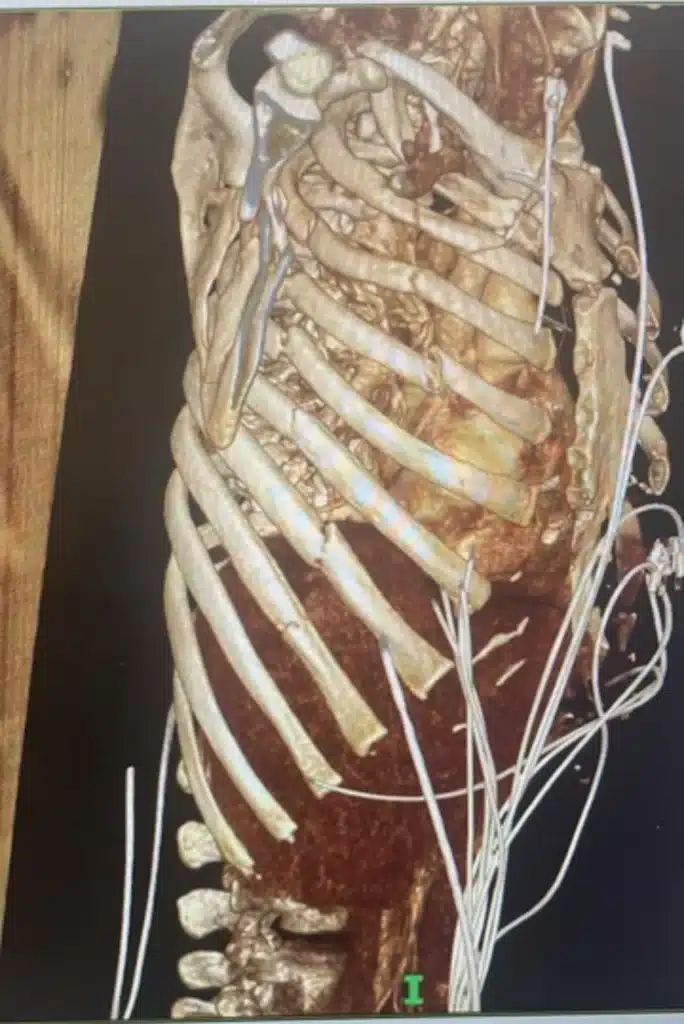
Seek Immediate Medical Attention for:
- Severe difficulty breathing or shortness of breath
- Signs of infection: fever, chills, worsening pain
- Chest pain that suddenly worsens significantly
- Coughing up blood or frothy sputum
- Signs of blood clots: leg swelling, chest pain, shortness of breath
Contact Your Doctor Within 24 Hours for:
- Pain that’s getting worse instead of better after the first week
- New or worsening respiratory symptoms
- Concerns about medication side effects
- Questions about activity restrictions
Long-Term Outlook and Prevention
Most patients with fractured ribs make complete recoveries and return to all previous activities without limitations.
Factors Affecting Recovery
Positive Factors:
- Younger age and good overall health
- Non-smoking status
- Compliance with treatment recommendations
- Adequate nutrition and rest
- Social support system
Challenging Factors:
- Advanced age or multiple medical conditions
- Multiple rib fractures or complications
- History of osteoporosis or bone disease
- Smoking or excessive alcohol use
Preventing Future Rib Fractures
Home Safety:
- Remove tripping hazards and improve lighting
- Use appropriate safety equipment during activities
- Maintain good bone health through diet and exercise
- Regular vision and balance assessments for older adults
Vehicle Safety:
- Always wear seatbelts properly
- Ensure proper airbag function
- Maintain safe driving practices
- Consider additional safety features in vehicles
Activity Safety:
- Use appropriate protective equipment for sports
- Learn proper techniques for physical activities
- Maintain good physical conditioning
- Avoid excessive alcohol use that might increase fall risk
Finding the Right Healthcare Team
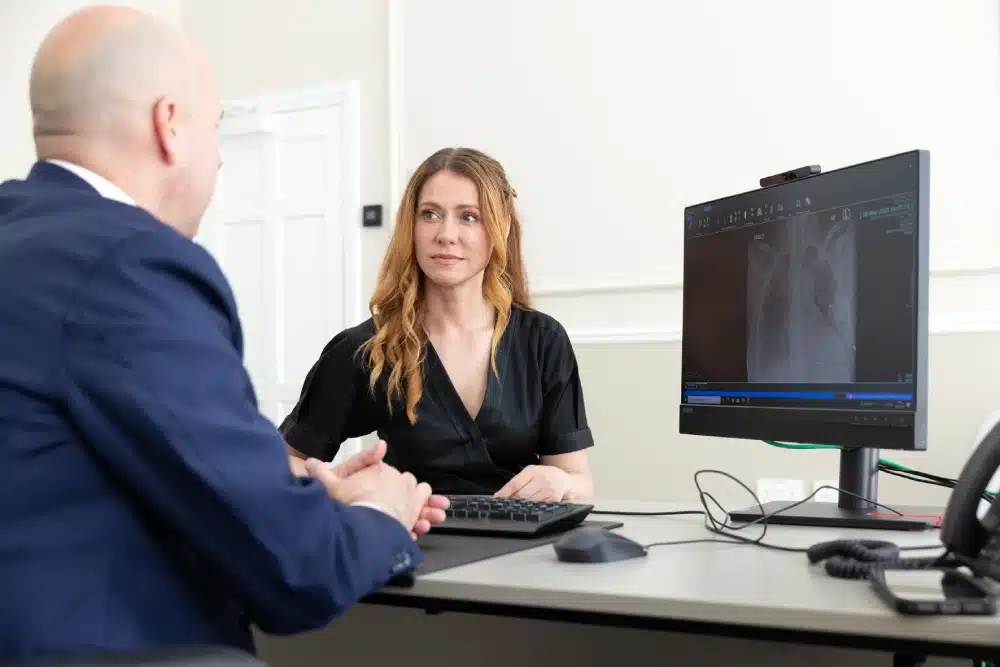
Having the right medical support makes a significant difference in your recovery experience.
Types of Healthcare Providers
Primary Care Physicians:
- Often, the first point of contact for rib injuries
- Coordinate care with specialists when needed
- Monitor overall health during recovery
- Specialists in chest injuries who evaluate the need for surgery and manage complex or slow-healing fractures.
- Evaluate the need for surgical intervention
- Manage complex or slow-healing fractures
Pain Management Specialists:
- Focus on comprehensive pain control strategies
- Offer advanced pain relief techniques
- Helpful for chronic or severe pain cases
Physical Therapists:
- Design exercise programs for recovery
- Teach proper movement techniques
- Help prevent future injuries
Questions to Ask Your Healthcare Provider
About Your Specific Injury:
- How severe is my fracture?
- What’s the expected healing timeline?
- Are there any complications I should watch for?
- When can I return to normal activities?
About Treatment Options:
- What are all my treatment choices?
- What are the benefits and risks of each option?
- How will we monitor my progress?
- When might we consider changing the treatment plan?
Conclusion: Your Path to Recovery

Dealing with fractured ribs can feel overwhelming initially, but understanding your treatment options and recovery process empowers you to take an active role in healing. Most patients recover completely within 6-8 weeks with proper care and patience.
Remember that healing is a gradual process, and it’s normal to have good days and challenging days during recovery. The key is following your treatment plan consistently, maintaining open communication with your healthcare team, and being patient with yourself as your body heals.
In most cases, fractured ribs heal fully, pain resolves, and patients return to their usual activities. By following evidence-based treatment approaches and listening to your body’s needs, you’re giving yourself the best chance for a complete and speedy recovery.
If you’re currently dealing with fractured ribs, know that you’re not alone in this journey. With proper treatment, support, and time, you’ll be back to feeling like yourself again. Stay positive, follow your treatment plan, and don’t hesitate to reach out to your healthcare team whenever you have questions or concerns about your recovery.
This article is for informational purposes only and should not replace professional medical advice. Always consult with qualified healthcare providers for diagnosis and treatment recommendations specific to your situation.